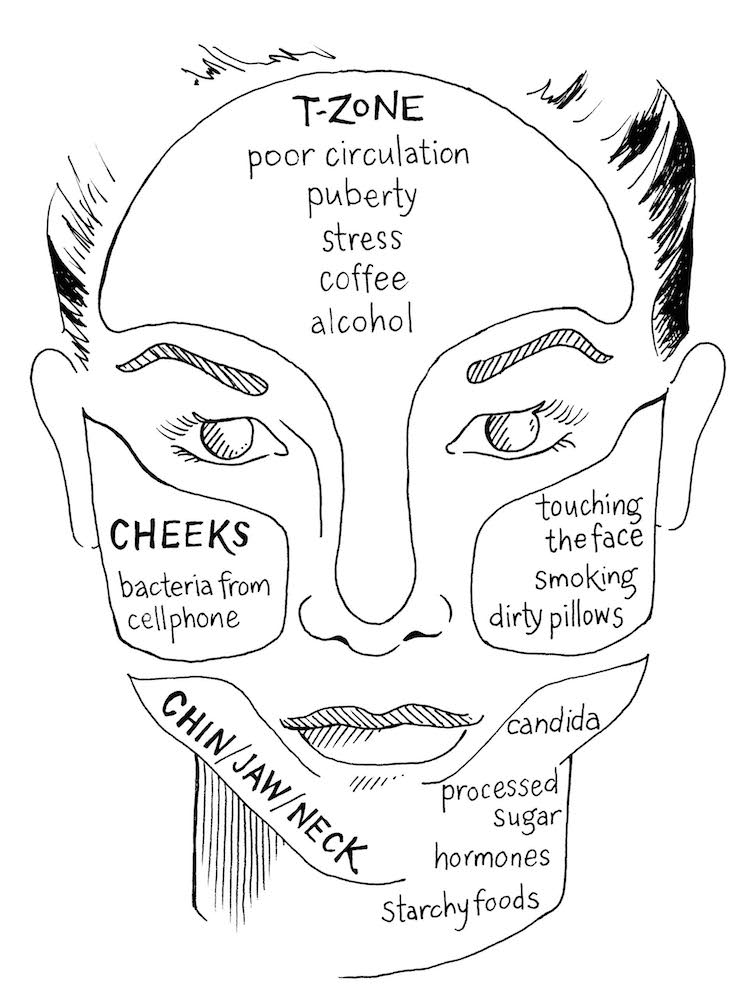Every couple of months, without a fail, my life has one explaining factor: Mercury retrograde. During that small but disruptive window, friends and I console each other, comforted by this uncontrollable fact. Suffering from “off energy?” Oh, it’s just Mercury in retrograde. Terrible date? Well, Mercury fucks up communication. Work sucks? Never sign a contract while Mercury is in retrograde!
But with breaking out? Blame Mercury if it’ll make you feel better, but chances are there are a few more factors at play.
According to Ayurvedic tradition, various areas on our body’s surface reflect our inner health, holistic aesthetician Monica Watters of Sacred Touch Holistic Skin and Body Care explains. Which brings us to the face map above—simply put, it's a way of examining which acne where is caused by what. In Ayurveda, where we break out, rash, wrinkle, and get dry is a direct line to establishing cause, and hopefully cure. Addressing imbalances in the body through diet is often the first step. Below is a region-by-region analysis, annotated by both Watters and Dr. Joshua Zeichner, the director of cosmetic and clinical research in the Dermatology Department at Mt. Sinai Hospital (because Eastern Medicine isn't always for everyone).
Chin/Jaw/Neck
Thank hormones and the good ol' menstrual cycle for breakouts in an area Dr. Zeichner affectionately calls “the beard of acne.” In addition to hormones, “blemishes on the jaw line and chin can also be caused by Candida and yeast overgrowth,” Watters explains. “So an anti-Candida diet is essential to heal the gut and clear up these breakouts.”
In addition to salicylic acid and benzoyl peroxide treatments (and potentially birth control pills if your doctor thinks they might help), Watters suggests cutting out heavy, creamy, starchy, damp, and fermented sweet foods like processed sugar, dried fruit, yeast, wine, dairy, white flour, gluten, soy, shellfish, fried foods, grapes, bananas, and peanut butter to help. Sure, it's basically all the fun stuff, but desperate times call for cutting out french toast.
Cheeks
Chances are your hands are the culprit of acne in this area. Try to avoid touching your face. Or, clean your cell phone with anti-bacterial wipes and change pillowcases and washcloths frequently. Otherwise, an accumulation of dirt and oil on the skin can clog pores. The cheeks also relate to the lungs and respiratory system so smoking may be another factor, Watters says.
T-Zone
The nose, forehead, and chin have the highest concentration of oil glands on the face. And it's no secret that puberty or intense times of stress can cause breakouts. The forehead also relates to the nervous system, digestive system, and Vata Dosha (the forces that govern the movement of the body, according to Ayurveda). So stress and internal dryness, stagnation of circulation or bowel congestion can be factors.
Watters recommends drinking more water and eating less processed foods, as well as reducing the amount of fat in your diet from cheese, milk, and hydrogenated oils. She also suggests taking digestive enzymes and probiotics or trying yoga, meditation, and breathwork to balance the nervous system. Blemishes on the nose can indicate circulatory or blood pressure issues. In that case, decrease your intake of spicy, pungent foods, meats, alcohol, and coffee. Increase your intake of good essential fatty acids, omega 3 and 6, flax seed, avocado, and olive oil to help. Alternatively, if you’re gearing up for midterms or a hectic time at work, Dr. Zeichner recommends preemptively revving up your normal acne treatment—or using salicylic acid or benzoyl peroxide proactively if your skin is typically clear.
Some of this may seem like common sense, or completely far-fetched if you’re a skeptic. Both reactions are fine. If concerns persist, see an actual doctor who makes you feel comfortable and can provide effective diagnoses and treatments. Or, check your Susan Miller—maybe it’s just Mercury.
—Alexis Cheung
Illustration by Samantha Dion Baker.

